Evaluation of Double-Sided Planetary Grinding Using Diamond Wheels for Sapphire Substrates
Abstract
:1. Introduction
2. Experimental
3. Results and Discussion
3.1. The Surface Quality Changing Process in Four Stages of Grinding Process
3.2. The Effect of Rotation Speed of Grinding Wheels
3.3. The Effect of Grinding Pressure
3.4. The Effect of the Grain Size of Grinding Wheel
3.5. The Dent Depth of Sapphire Surface
4. Conclusions
- (1)
- The grinding process is set into four stages, which can obtain a stable grinding process and improve the processing quality.
- (2)
- The good surface quality of the sapphire substrate (TTV ≤ 6 µm, Bow ≤ 2 µm, Warp ≤ 12 µm, Ra ≤ 390 nm) and high efficiency (MRR = 10.0 µm/min) can be achieved when grinding under the suitable rotational speed of the grinding wheel (120 rpm) and at a suitable grinding pressure (20.5 kPa).
- (3)
- The grinding of sapphire substrates shows an approximate linear dependence on the MRR with grinding pressure, the grinding wheel’s speed, and the grain size.
- (4)
- The larger size of the diamond grains (60 µm) could be used in double-sided planetary grinding to obtain higher processing efficiency with the promise of good surface quality.
Author Contributions
Funding
Conflicts of Interest
References
- Chen, W.C.; Tang, H.L. Research progress in light-emitting diode substrate materials. J. Phys. 2014, 63, 284–295. [Google Scholar]
- Yang, J.S.; Zhu, X.L.; Dong, Z.G.; Kang, R.K.; Guo, D.M.; Zhang, B. Design of Double-sided Polishing Machine for Functional Crystal Substrate. Adv. Mater. Res. 2014, 1017, 580–585. [Google Scholar] [CrossRef]
- Li, Z.C.; Pei, Z.J. Machining process for Sapphire Wafers: A Literature Review. Proc. Inst. Mech. Eng. Part B J. Eng. Manuf. 2011, 225, 975–989. [Google Scholar] [CrossRef]
- Pei, Z.J.; Fisher, G.R.; Strasbaugh, A. Fine Grinding of Silicon Wafer: Benefits and Technical Barriers; Society of Manufacturing Engineers: Dearborn, MI, USA, 2004; pp. 284–295. [Google Scholar]
- Pei, Z.J.; Strasbaugh, A. Fine grinding of silicon wafers. Int. J. Mach. Tools Manuf. 2001, 41, 659–672. [Google Scholar] [CrossRef]
- Pei, Z.J.; Strasbaugh, A. Fine grinding of silicon wafers: Designed experiments. Int. J. Mach. Tools Manuf. 2002, 42, 395–404. [Google Scholar] [CrossRef]
- Chidambaram, S.; Pei, Z.J.; Kassir, S. Fine grinding of silicon wafers: A mathematical model for the chuck shape. Int. J. Mach. Tools Manuf. 2003, 43, 739–746. [Google Scholar] [CrossRef]
- Sun, W.P.; Pei, Z.J.; Fisher, G.R. Fine grinding of silicon wafers: A mathematical model for the wafer shape. Int. J. Mach. Tools Manuf. 2004, 44, 707–716. [Google Scholar] [CrossRef]
- Sun, W.P.; Pei, Z.J.; Fisher, G.R. Fine grinding of silicon wafers: Machine configurations for spindle angle adjustments. Int. J. Mach. Tools Manuf. 2005, 45, 51–61. [Google Scholar] [CrossRef]
- Shaw, M.C. Principles of Abrasive Processing; Oxford University Press: New York, NY, USA, 2000; p. 201. [Google Scholar]
- Su, J.X.; Liu, X.L.; Liu, Z.X. Experiment on lapping 6H-SiC crystal substrate (0001) Si surface based on diamond particle. J. Manuf. Process. 2013, 15, 148–154. [Google Scholar]
- Fang, C.F.; Zhao, Z.X.; Lu, L.Y. Influence of fixed abrasive configuration on the polishing process of silicon substrates. Int. J. Adv. Manuf. Technol. 2016, 90, 50–61. [Google Scholar]
- Yuan, J.L.; Yao, W.F.; Zhao, P.; Lyu, B.H.; Chen, Z.X.; Zhong, M.P. Kinematics and trajectory of both cylindrical lapping process in planetary motion type. Int. J. Mach. Tools Manuf. 2015, 92, 60–71. [Google Scholar] [CrossRef]
- Lu, J.; Luo, Q.F.; Mao, X.Y.; Xu, X.P.; Wang, Y.H.; Guo, H. Fabrication of a resin-bonded ultra-fine diamond abrasive polishing tool by electrophoretic co-deposition for SiC processing. Precis. Eng. 2017, 47, 353–361. [Google Scholar] [CrossRef]
- Liu, J.H.; Yang, J.D. The study of lapping trace by graphic transform on double-side lapping through a planet mechanism. J. Changchun Univ. Sci. Technol. 2002, 25, 40–42. [Google Scholar]
- Ku, L.M.; Yan, Z.; Suo, S.; Chang, Q.; Zhou, Q. Mathematical modeling and analysis of double-sided polishing process for 300 mm silicon substrates. Microelectronics 2008, 3, 373–376. [Google Scholar]
- Jin, Y.F.; Li, W.; Hu, G.X.; Hu, X.Z. Motion analysis for double-sided polishing process and mathematical model establishing. J. Nanjing Univ. Aeronaut. Astronaut. 2005, 37, 86–89. [Google Scholar]
- Kondratenko, V.S. Grinding Tool and Composition for Its Producing. Russian Patent RU 2169657, 27 June 2001. [Google Scholar]
- Kondratenko, V.S. Method of Abrasive Machining of Workpiece. Russian Patents RU 2172235, 20 August 2001. [Google Scholar]
- Kondratenko, V.S. Grinding Tool. Russian Patents RU 2208511, 20 July 2003. [Google Scholar]
- Gagliardi, J.J.; Kim, D.; Sokol, J.J.; Zazzera, L.A.; Romero, V.D.; Atkinson, M.R.; Zhang, H. A Case for 2-body Material Removal in Prime LED Sapphire Substrate Lapping and Polishing. J. Manuf. Process. 2013, 15, 348–354. [Google Scholar] [CrossRef]
- Cho, B.J.; Kim, H.M.; Manivannan, R.; Moon, D.J.; Park, J.G. On the mechanism of material removal by fixed abrasive lapping of various glass substrates. Wear 2013, 302, 1334–1339. [Google Scholar] [CrossRef]
- Kim, H.M.; Park, G.H.; Seo, Y.G.; Moon, D.J.; Cho, B.J.; Park, J.G. Comparison between sapphire lapping processes using 2-body and 3-body modes as a function of diamond abrasive size. Wear 2015, 332–333, 794–799. [Google Scholar] [CrossRef]
- Kim, H.M.; Manivannan, R.; Moon, D.J.; Xiong, H.; Park, J.G. Evaluation of double sided lapping using a fixed abrasive pad for Sapphire substrates. Wear 2013, 302, 134–145. [Google Scholar] [CrossRef]
- Jiang, F.; Luan, X.S.; Wang, N.C.; Xu, X.P.; Lu, X.Z.; Wen, Q.L. Research on the dynamic mechanical properties of C-plane sapphire under impact loading. Ceram. Int. 2018, 44. [Google Scholar] [CrossRef]
- Wang, J.H.; Guo, B.; Zhao, Q.L.; Zhang, C.Y.; Zhang, Q.L.; Zhai, W.J. Evolution of material removal modes of sapphire under varied scratching. Ceram. Int. 2017, 43, 10353–10360. [Google Scholar] [CrossRef]
- Luo, Q.F.; Lu, J.; Xu, X.P.; Jiang, F. Removal mechanism of sapphire substrates (0001, 1120 and 1010) in mechanical planarization machining. Ceram. Int. 2017, 43, 16178–16184. [Google Scholar] [CrossRef]
- Wang, L.J.; Hu, Z.W.; Fang, C.F.; Yu, Y.; Xu, X. Study on the double-sided grinding of sapphire substrates with the trajectory method. Precis. Eng. 2018, 51, 308–318. [Google Scholar] [CrossRef]
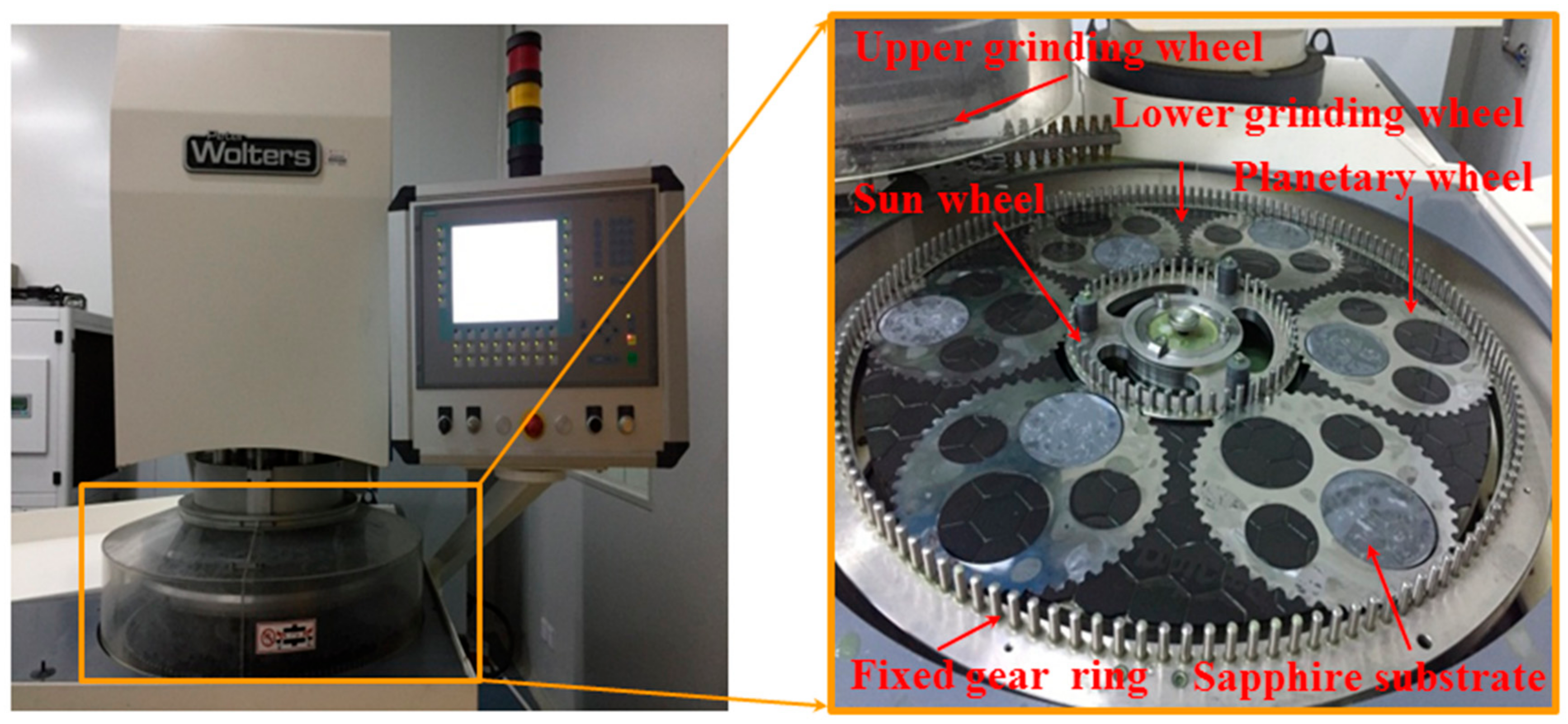
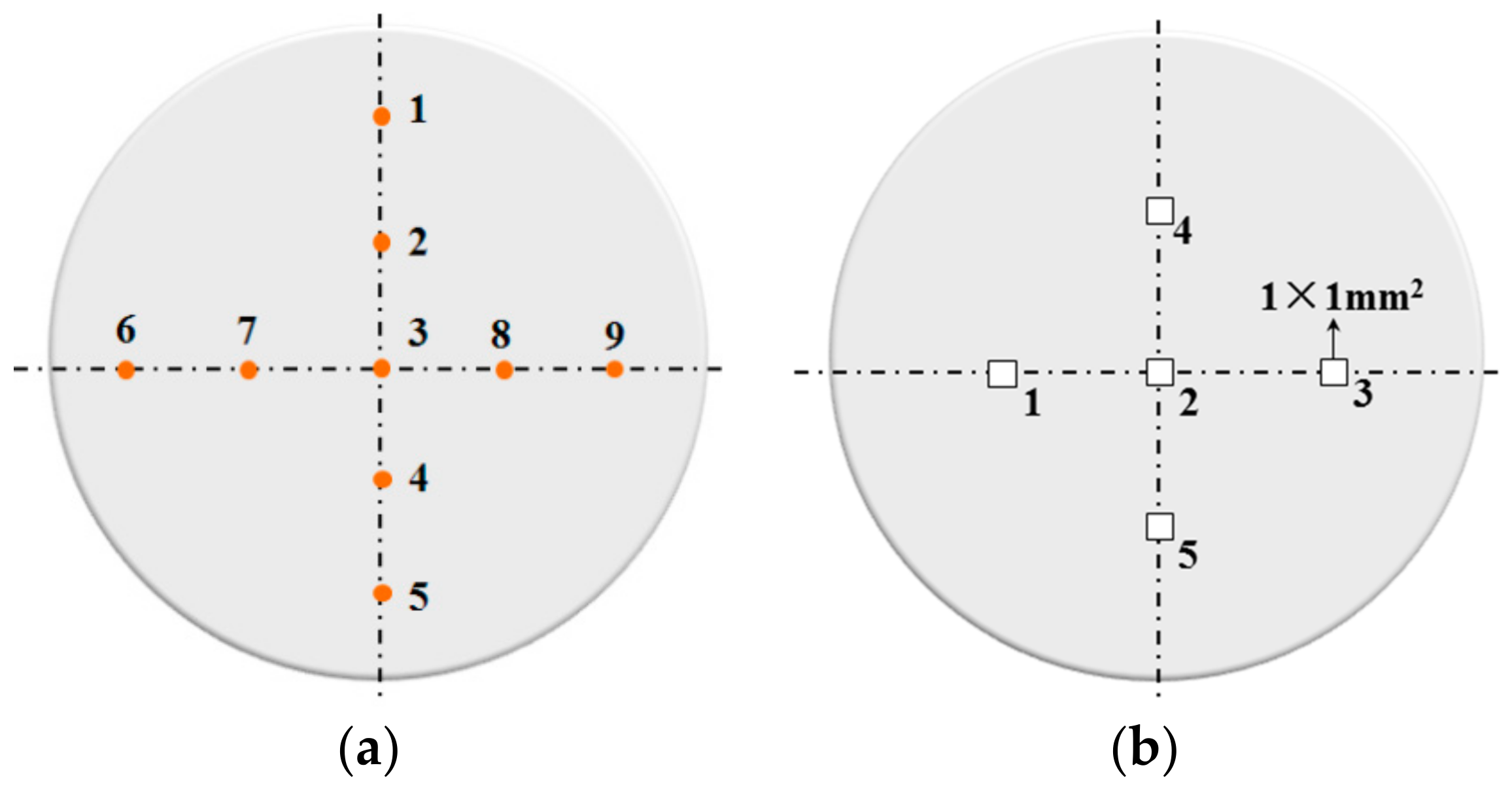

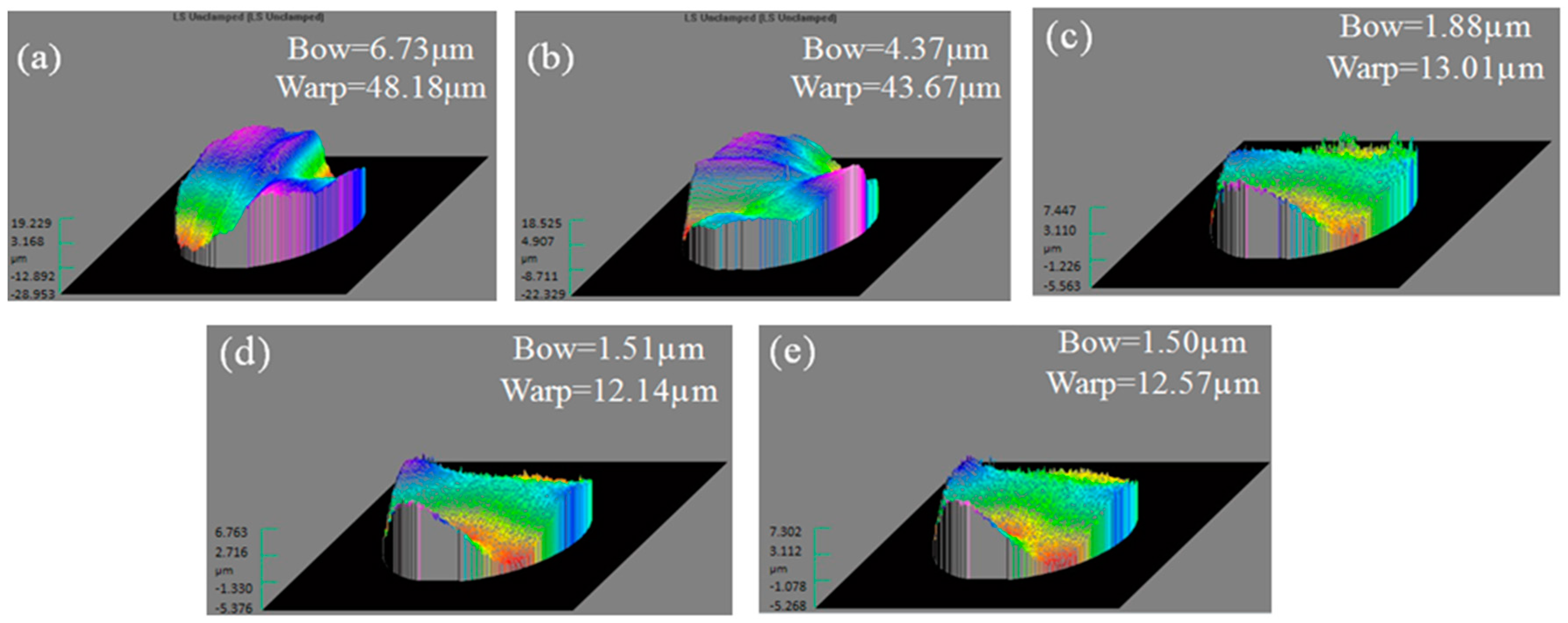

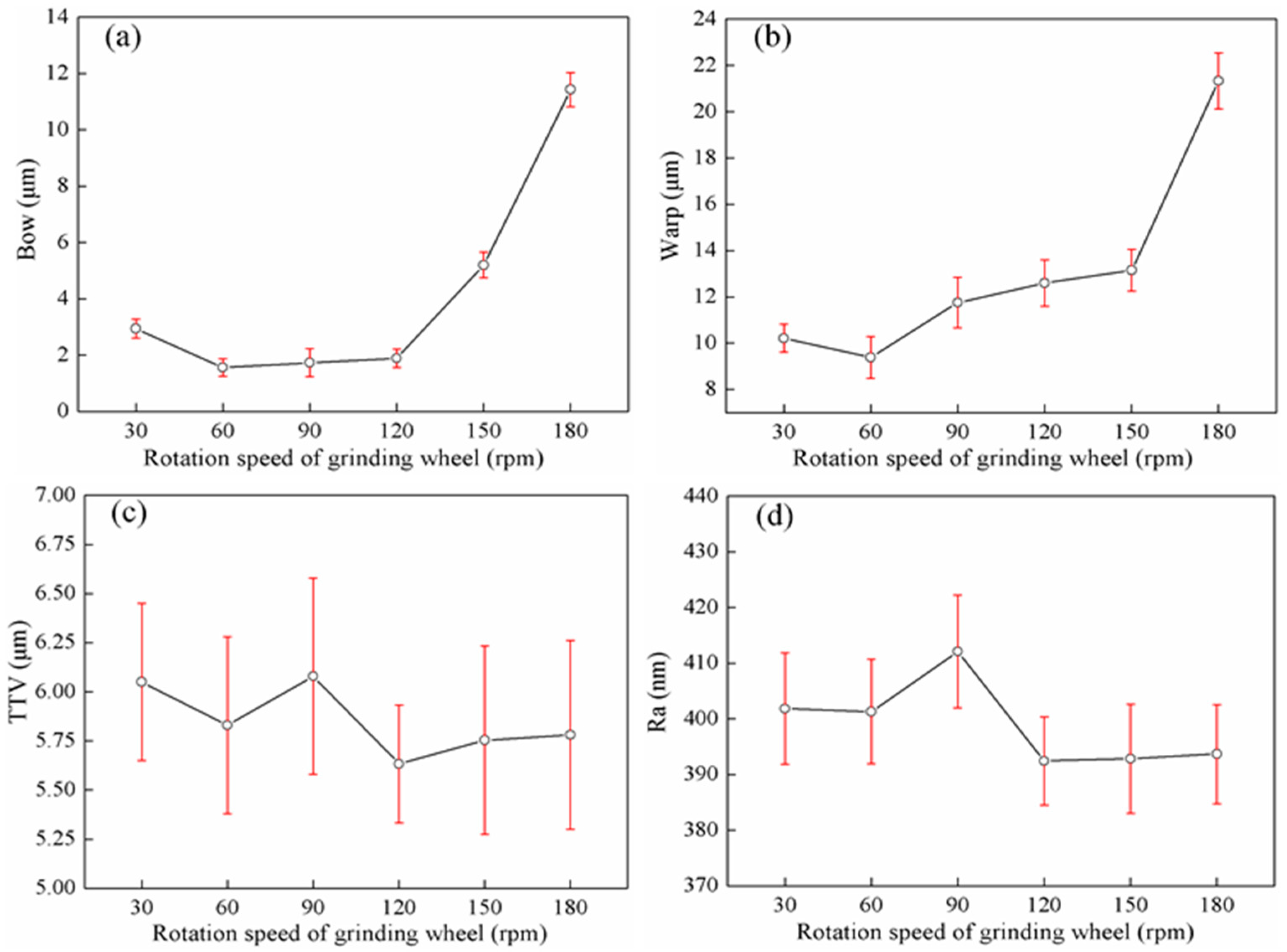



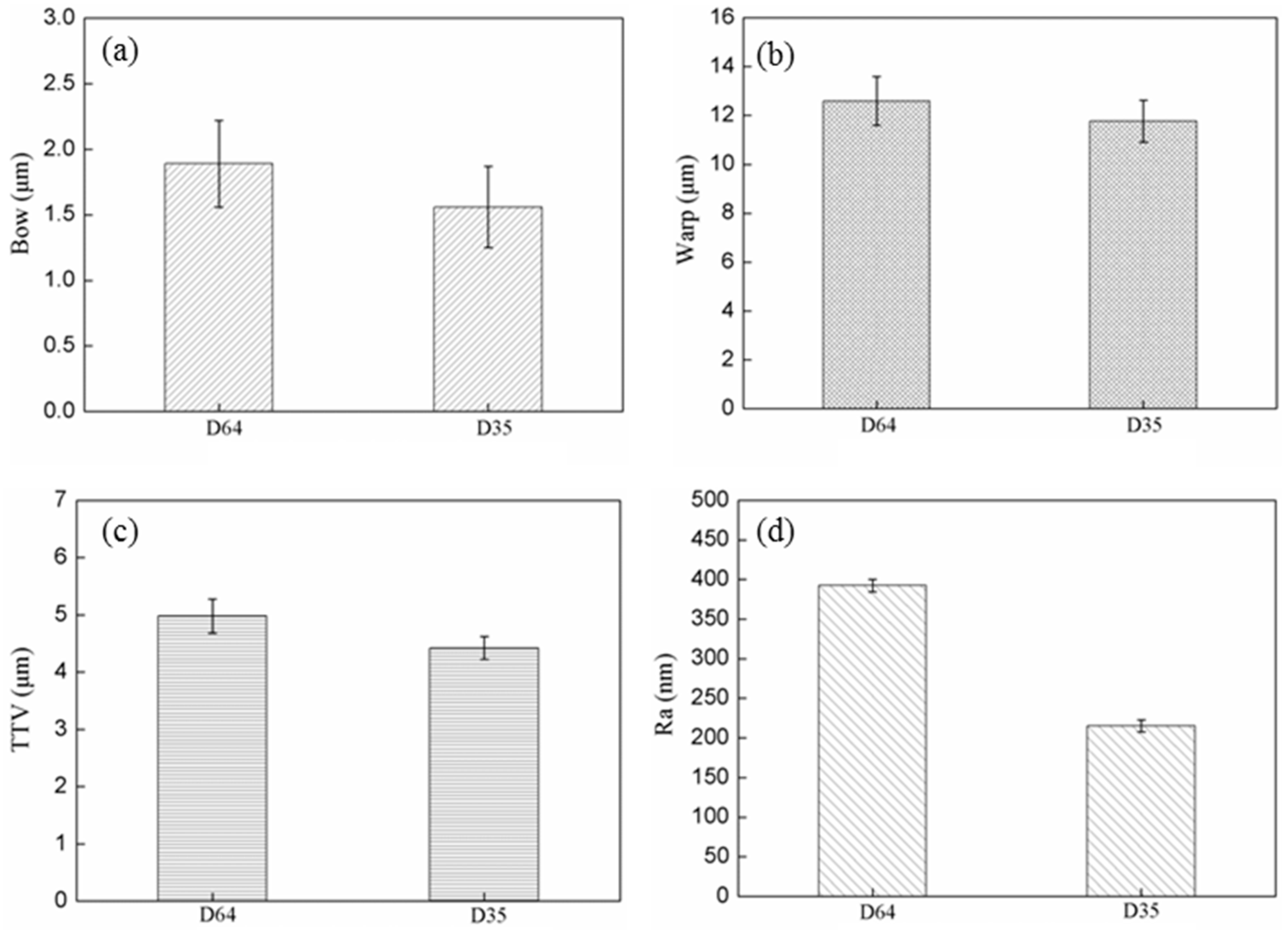


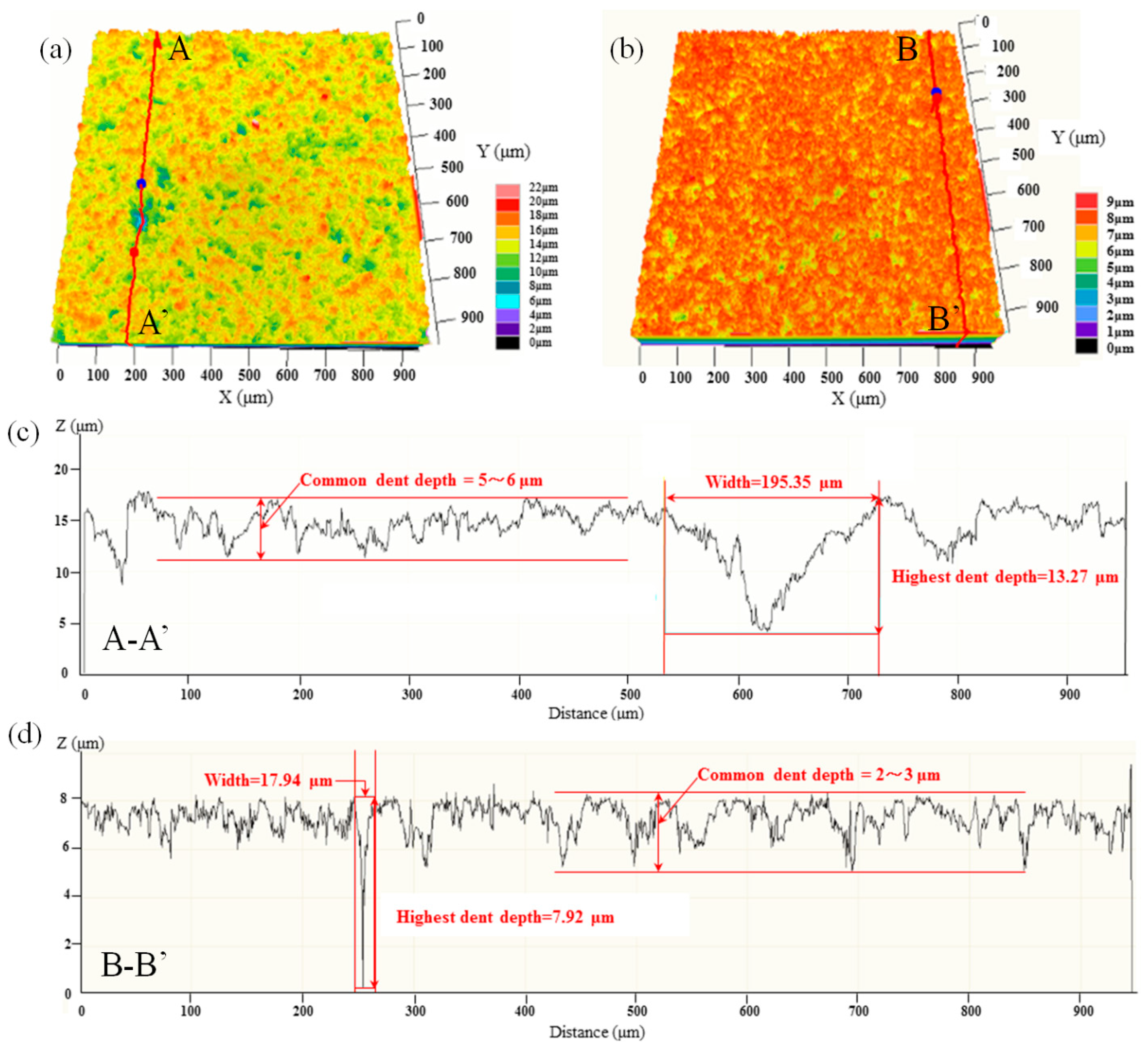
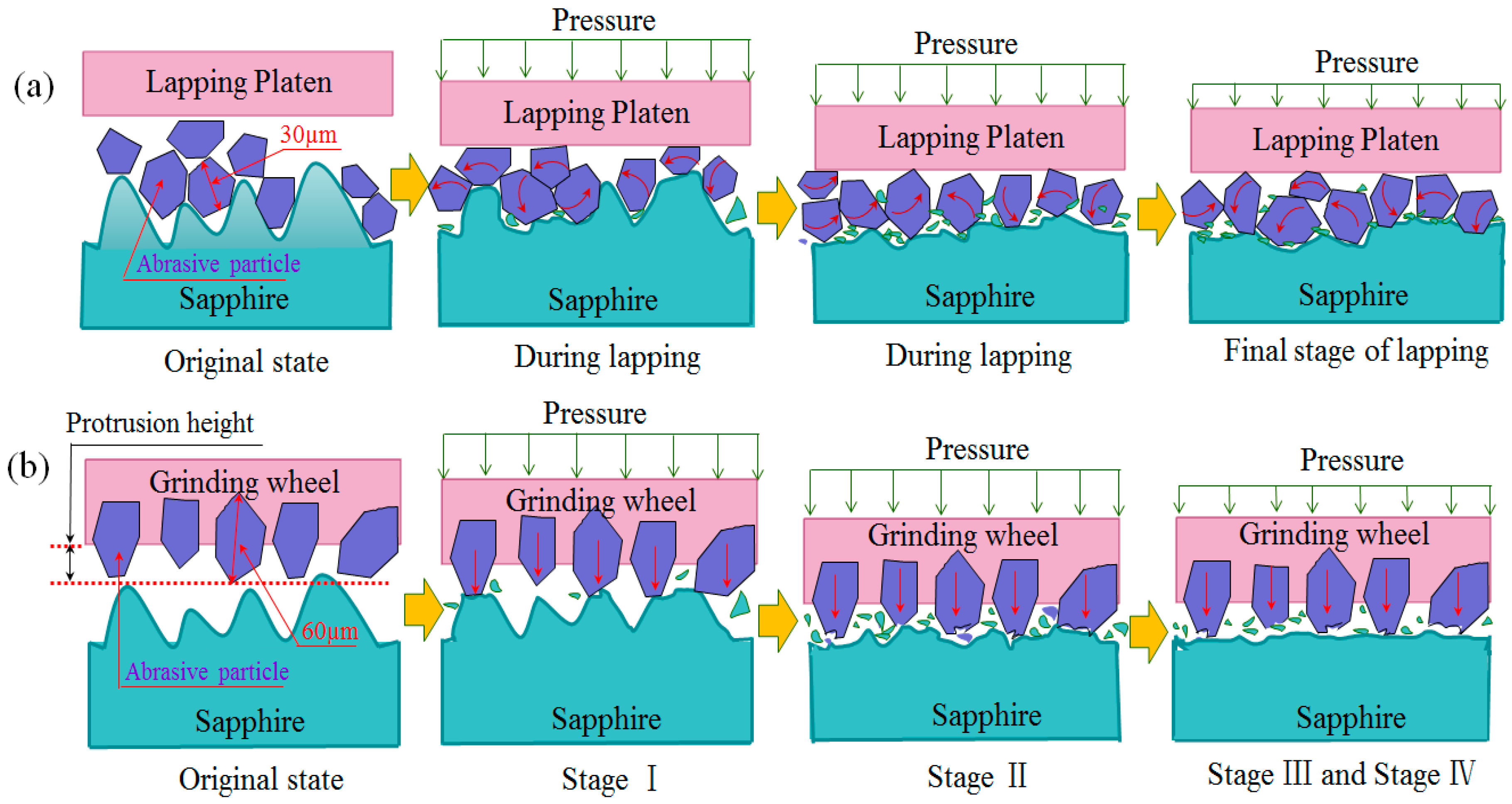
| Rotation Speed of Upper Grinding Wheel (rpm) | Rotation Speed of Lower Grinding Wheel (rpm) | Rotation Speed of the Sun Wheel (rpm) | Grinding Pressure (kPa) | Removal Thichness (µm) | Coolant Switch | |
|---|---|---|---|---|---|---|
| Stage I | 60 | −60 | 10 | 0~20.5 | 0 | on |
| Stage II | 90 | −90 | 10 | 20.5 | 70 | on |
| Stage III | 60 | −60 | 10 | 6.15 | 8 | on |
| Stage IV | 60 | −60 | 10 | 2.05 | 2 | off |
© 2018 by the authors. Licensee MDPI, Basel, Switzerland. This article is an open access article distributed under the terms and conditions of the Creative Commons Attribution (CC BY) license (http://creativecommons.org/licenses/by/4.0/).
Share and Cite
Wang, L.; Hu, Z.; Yu, Y.; Xu, X. Evaluation of Double-Sided Planetary Grinding Using Diamond Wheels for Sapphire Substrates. Crystals 2018, 8, 262. https://doi.org/10.3390/cryst8070262
Wang L, Hu Z, Yu Y, Xu X. Evaluation of Double-Sided Planetary Grinding Using Diamond Wheels for Sapphire Substrates. Crystals. 2018; 8(7):262. https://doi.org/10.3390/cryst8070262
Chicago/Turabian StyleWang, Lijuan, Zhongwei Hu, Yiqing Yu, and Xipeng Xu. 2018. "Evaluation of Double-Sided Planetary Grinding Using Diamond Wheels for Sapphire Substrates" Crystals 8, no. 7: 262. https://doi.org/10.3390/cryst8070262




